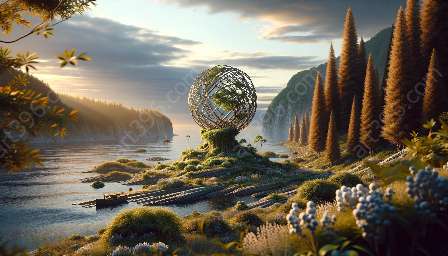Environmental art, a genre that emerged in the late 20th century, encompasses a wide range of artistic practices that engage with the natural environment and address ecological concerns. Found objects and natural materials play a significant role in this form of artistic expression, highlighting the creative fusion of art and the environment. Let's delve into the intriguing world of material use in environmental art and explore the diverse concepts shaping environmental art.
Material Use in Environmental Art
The use of found objects and natural materials in environmental art reflects a deep-rooted connection to the natural world. Artists working in this genre often seek to minimize their ecological footprint by repurposing discarded items and integrating elements from the environment into their creations. By utilizing found objects and natural materials, these artists demonstrate a commitment to sustainability and environmental stewardship, transforming mundane or overlooked items into thought-provoking works of art.
Exploring Creativity and Sustainability
One of the compelling aspects of incorporating found objects and natural materials into environmental art is the emphasis on creativity and sustainability. Artists harness their imagination to reimagine the potential of discarded items, breathing new life and meaning into materials that might otherwise contribute to environmental waste. In doing so, they offer a fresh perspective on consumption and waste, prompting viewers to reconsider their relationship with the material world and the impact of human activities on the environment.
Embracing Site-Specific Art
Many environmental artists are drawn to the concept of site-specific art, which involves creating works that are uniquely tailored to a particular environment or location. Found objects and natural materials serve as essential building blocks for these site-specific installations, enabling artists to engage directly with the environment in which their art is situated. By seamlessly blending their creations with the natural landscape, artists invite viewers to consider the interconnectedness of art and the environment, fostering a deeper appreciation for the beauty and fragility of the natural world.
Environmental Art Concepts
Environmental art encompasses a multitude of concepts and approaches, reflecting the diverse ways in which artists engage with environmental issues and the natural world. Whether through sculptures, installations, or land art, these concepts offer thought-provoking insights into our relationship with the environment and the urgent need for environmental conservation and sustainability.
Ecological Awareness
Artists who incorporate found objects and natural materials in their work often convey messages of ecological awareness and environmental advocacy. Through their art, they draw attention to pressing environmental issues, such as pollution, deforestation, and climate change, prompting viewers to confront these challenges and consider their own role in safeguarding the planet. By evoking emotional responses and prompting critical reflection, environmental art becomes a powerful medium for fostering ecological consciousness and inspiring positive action.
Transience and Impermanence
For artists working with natural materials, an inherent theme often revolves around the concepts of transience and impermanence. Natural elements, such as leaves, branches, and earth, are subject to the forces of time and the environment, ultimately undergoing processes of decay and transformation. By embracing these transient qualities in their art, artists convey poignant reminders of the impermanence of life and the fleeting nature of the natural world, prompting viewers to contemplate the cycle of growth, decay, and regeneration inherent in all living organisms.
Bio-Art and Ecological Restoration
Incorporating found objects and natural materials into artistic practices extends beyond mere aesthetic expression, often intersecting with the realm of bio-art and ecological restoration. Some environmental artists actively engage in ecological restoration projects, using their art as a catalyst for environmental renewal and conservation. Whether through reforestation efforts, habitat preservation, or sustainable land management, these artists merge their creative endeavors with tangible environmental initiatives, contributing to the preservation of biodiversity and the restoration of ecosystems.

